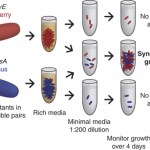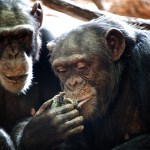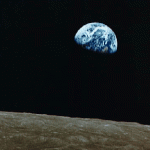emergence
My good friend and labmate just published an awesome paper: "Emergent cooperation in microbial metabolism." His experiment started with 46 strains of E. coli that had mutations in their metabolic pathways that prevented them from being able to grow without supplementing the media with extra metabolites. Alone they died, but grown together in the same tube, many pairs of mutants were able to feed each other the missing metabolite. Metabolic cooperation was the key to survival.
Measuring and understanding metabolic cooperation can be used to build stronger, more predictive models of…
There's some good stuff in yesterday's post asking what physics you'd like to read more about. I'm nursing a sore neck and shoulder, so I'll only do one or two quick ones today, starting with James D. Miller in the first comment:
1) Is it true that our understanding of quantum physics comes from studying systems with only a small number of particles and there is a good chance our theories won't hold in more complex systems.
It all depends on how you define your terms-- what counts as a "small number" of particles, and what counts as not holding?
It's certainly true that most of the…
New research finds chimpanzees follow prestigious models when learning new tasks. Monika Thorpe / Creative CommonsIf one were to play psychiatrist to the natural world, most human beings would be committed for our certifiable obsession with other peoples' behavior. We compulsively examine, study, appraise, size up, and scope out what those around us are doing and then gossip with others about what we've seen or heard. New ideas or behaviors are especially compelling and will often have cultural critics…
Author's Note: This post was selected as the topic for the ResearchBlogCast as part of ResearchBlogging.org. Listen to the discussion here.
Could punishing bad behavior be the origin of human cooperation?Humans are one of the most cooperative species on the planet. Our ability to coordinate behavior and work collaboratively with others has allowed us to create the natural world's largest and most densely populated societies, outside of deep sea microbial mats and a few…
Image: The Daffodil Cichlid of Lake Tanganyika / Koen Eeckhoudt
In 1888 "Darwin's Bulldog", Thomas Henry Huxley, declared that nature was little more than a "gladiator's show" whereby only "the strongest, the swiftest, and the cunningest live to fight another day." Brutal competition was the only important factor in the natural world, in which a "Hobbesian war of each against all was the normal state of existence." As such, we shouldn't expect cooperation in nature because only strength and selfishness is rewarded by evolution.
But a paper by Dik Heg and colleagues, entitled Helpful Female…
Groups of individuals (from molecules to cells to animals) following simple rules and responding to environmental cues will create the amazingly complex emergent behaviors we see in nature, making cells, bodies, and societies far more than the sum of their parts. Each individual acts without knowing what the final outcome will be, whether it's birds flying in formation, termites building intricate underground tunnels, or human societies building cities and networks. At a molecular level, one of the most striking examples of emergent behavior is embryonic body pattern formation. Every cell in…
Seed magazine has just posted my review of Frans de Waal's The Age of Empathy: Nature's Lessons for a Kinder Society. I wanted to use this opportunity to thank Nikki, Evan, Bora and everyone else that helped in developing this piece. For posts on related topics please see Misunderstanding Dawkins, The Sacrifice of Admetus, Bonobos "Red in Tooth and Claw", The Evolution of Morality and Laboratory Evidence for the Breakdown of the Selfish Gene.
In a fitting metaphor, the most recent experiment with social darwinism resulted in mass extinction. Former Enron CEO Jeffrey Skilling claimed he was…
Heracles battles Death for generosity's sake / Frederic Lord Leighton (1869-71)
Whereas great scientific theories stand the test of time when they accurately predict the natural world through repeated empirical trials, great literature transcends the ages when it speaks to universal qualities of human experience. Such inspirational works can also, without the authors realizing at the time, reveal the sublime beauty and tragedy of our evolutionary drama. Few classical authors have tapped into this zeitgeist of biological experience as the Greek tragedian Euripides. The conflict between…
My previous post on a potential problem for the selfish gene theory in explaining cooperative behavior resulted in a fair amount of heated discussion. However, there are quite a few misconceptions regarding the controversy surrounding the selfish gene, group selection, multilevel selection, generalized reciprocity, etc. that need to be clarified. When Richard Dawkins published The Selfish Gene in 1976 it was an instant classic and has been championed for the past three decades as the final answer on how natural selection operates. What has been tremendously useful about the theory, as in…
Unicolonial ants, such as these Argentine ants (Linepithema humile), are genetically unrelated but will cooperate to defeat a much larger adversary.
Source: Alex Wild / Live Science
It has been a mainstay of evolutionary theory since the 1970s. Natural selection acts purely on the level of the individual and any cooperation observed between organisms merely hides a selfish genetic motive. There have been two pioneering theories to explain cooperation in the natural world given this framework: the first was William Hamilton's (1964) theory of kin selection and the second was Robert Trivers…
As you may have noticed from yesterday's unusual post, today is Earth Day! I thought I'd share with you some of my favorite pictures from space of it, including the famous photograph from Apollo 8 known as Earthrise:
This combination shot made from NASA’s Terra satellite and NOAA’s Geostationary Operational Environmental Satellite:
The known satellites at least 0.1 meters in size in orbit around Earth (there are ~11,000 of them as of April 2005, and another 100,000 between 1 cm and 10 cm in size):
Looking at the Earth and the docked Space Shuttle from the International Space Station:
And…




